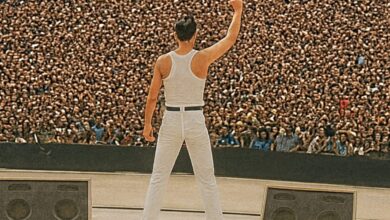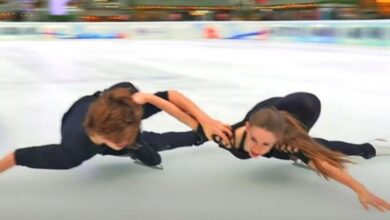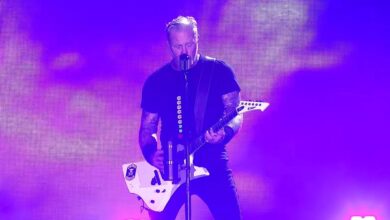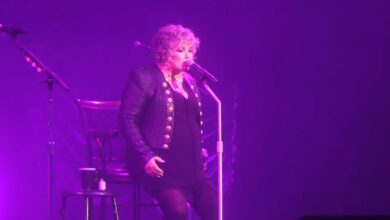Limp Bizkit – “Break Stuff” (Live at Woodstock 1999) — The Day Nu-Metal Burned Brightest and Changed Festival History Forever
During the late-afternoon heat of July 24, 1999, the East Stage at Griffiss Air Force Base felt less like a concert platform and more like a pressure valve about to blow. When Limp Bizkit strode out and the opening thump of “Break Stuff” rattled the PA, the crowd’s temperature seemed to leap another ten degrees. Even on VHS-era footage you can sense the scale—an endless sea of bodies pushing and recoiling—and in the cleaned-up, official pro-shot uploads the edges are sharper still: a lens trained on a generation’s adrenaline spiking in real time. The riff lands, the snare smacks, and thousands of fists answer back, a human metronome keeping time with pure impulse.
What made this performance instantly magnetic—beyond the obvious hit-song bait—was how tight the band played while surfing a volatile wave. Fred Durst works the barricade line like a carnival barker and ringleader rolled into one, winding a pre-smartphone era audience with back-and-forth callouts and sly provocations. Wes Borland turns abrasion into theater, his guitar carving percussive slabs that leave air pockets for the hook to explode. John Otto’s drums move like a stampede but hit like punctuation—full stops, hard returns—while DJ Lethal salts the silences with needle-flicks and siren-like swells. The groove never stumbles; it stalks.
By the first chorus, you can see Woodstock ’99’s sprawling ambition colliding with its own logistics. The pit isn’t a circle—it’s a continent, shifting shape with each dynamic drop. “Break Stuff” is built on tension and release, and in Rome, New York, the release felt communal and combustible at once. You watch it crest in the wide shots: people surfing by the dozen, plywood planks held aloft like makeshift rafts, a thousand micro-dramas playing out between the kick drum hits. It’s the strange theater of festival catharsis—half choreography, half chaos—captured with the crystalline indifference of a pro camera.
Part of the mythology comes from the patter between songs, snippets that survived on broadcast tapes and later restorations. Durst’s on-mic bravado, alternately cautioning the crowd to pick each other up and fanning the flame of “let yourself go,” sounded to some like the language of release and to others like a match near dry tinder. The nuance often gets lost in hindsight debates, but in the moment the message read as code for the culture: don’t mellow out, but don’t leave anyone behind. It was the late-’90s mosh-pit social contract, shouted over subs that could loosen fillings.
The camera work adds to the myth. There’s a ruthless efficiency to the way the official shot cuts from the macro—the human tide, the horizon of bobbing heads—to the micro: a kid’s face mid-scream, a security guard’s split-second nod, Borland’s fretting hand twitching between harmonics. No matter how many remasters or cleaned-up AAC uploads circulate, the essence remains the same: this is a crowd performance as much as a band performance. The song is the script; the audience provides the plot twists. And on this day, the plot kept thickening.
If you isolate the music, “Break Stuff” is almost austere: a handful of parts, welded with intention, designed to make bodies move whether they want to or not. That simplicity is why it scales, why 5,000 kids in a club or 200,000 people on a tarmac react with the same spinal reflex. Otto and the low end turn repetition into hypnosis; Borland’s guitar cures the repetition with bite; Durst’s cadences take the place of melody until the hook detonates. At Woodstock ’99, that spare architecture became a cathedral of noise—huge, echoing, and, in moments, unruly.
What’s often overlooked is how elastic the band is inside that spare framework. Listen closely in the pro-shot audio and you hear Otto tug the groove just behind the beat to make the chorus feel heavier, or DJ Lethal slip a sample tail under a drop so the return hits like a spring uncoiling. Borland’s tone isn’t static, either; he shaves off gain for clarity in the verses, then pours it back on for the punch-ins. The result is a live “Break Stuff” that pumps like a heart under duress: same pulse, different pressure with each surge of the crowd.
Of course, the performance’s legend is entangled with the festival’s darker footnotes. Woodstock ’99’s infrastructure—security, water, heat management—was already sagging by Saturday evening, and a set designed as catharsis became a lightning rod. In the days and years after, investigators and journalists tried to apportion responsibility: to the promoters who misread the environment, to the conditions that frayed tempers, to specific moments when energy tipped into harm. Rewatching the set today, you see the hinge points: the staffers conferring side-stage, the announcements to ease up, the crowd refusing to go quietly into a summer night.
But to understand why the clip endures—why it gets reposted, remastered, and re-argued—you have to zoom back to the music’s function. “Break Stuff” gives shape to frustration without needing a manifesto. It’s a ritual of exorcism in three minutes and change, a pre-algorithm hit that knew exactly how to weaponize silence before the downbeat and pay it off with a communal shout. In Rome, that ritual hit a fault line in the culture: kids raised on alt-radio and dial-up discovering what happens when the crowd is the weather, and the weather turns.
For the band, the moment was both pinnacle and Rorschach test. Some saw instigation; others saw mirror. Durst’s charisma reads, depending on your priors, as reckless spark or necessary conductor for energy that would have discharged somewhere, somehow. Borland’s art-house menace either dignifies the roar with surreal flair or dresses a riot in cool clothes. What’s undeniable in the footage is that they are locked in, not searching for the pocket but living in it, and that the crowd—this crowd—was ready to follow every stop-time cue like a cliff’s edge dared them to jump.
There’s also the sobering coda of what else happened that weekend: reports of assaults, fires, breakdowns in basic care. To canonize the performance without acknowledging that context is to flatten it into meme. The pro-shot clarity doesn’t erase the blur at the edges; if anything, it renders the contrast starker—the thrill of a band at its combustible best against the stark reality that a festival is not just a stage and a camera angle but an ecosystem that can fail. Watching now means holding both truths in your head at once.
Two and a half decades later, the clip functions as more than nostalgia bait. It’s a document of late-’90s crowd physics before smartphone choreography and LED wristbands tamed the spectacle. The plywood surfing, the shoulder-to-shoulder sway, the crowd’s roar louder than any click track—all of it feels like a dispatch from a wilder frontier of live music. And because it lives online in crisp angles and restored audio, each new generation meets it not as folklore but as evidence: this actually happened, exactly like that.
Revisiting “Break Stuff” now also casts a long, bittersweet shadow because of Sam Rivers’ recent passing at 48. In the Woodstock footage, you can feel his role as ballast: the tone fat but unbloated, the lines simple enough to anchor a moving ocean while elastic enough to let it breathe. Bass in a band like Limp Bizkit is both engine and governor; Rivers was the kind of player who could make aggression feel musical and motion feel inevitable. To hear that low end now is to hear the blueprint of how this band made bodies move.
Fans and press described Rivers as the heartbeat of the group, and that’s not eulogy hyperbole; it’s just accurate. On a night when cues could have vanished into chaos, his pulse doesn’t flinch. When the downbeat returns after a breakdown, it’s his note that tells ten thousand feet when to jump again. Even amid the spectacle—the plywood, the swells, the sudden lurches—his presence is the quiet insistence that turns noise into song. The clip survives because it’s thrilling; it deepens now because we understand more clearly what, and who, made it hold together.
There is an odd grace in the way legacy re-edits itself. The pro-shot angles that once served as bragging rights for a generation’s favorite mosh-pit now double as a memorial reel for a musician whose feel defined a band. You press play for the chaos, and stay—for the hundredth time—for the groove. The camera lands on Rivers, calm in the storm, and you realize that the most intense thing on the screen isn’t the crowd surge; it’s the steadiness of a bassist who knew exactly where the floor was and kept it from giving way.
If Woodstock ’99 is often framed as the end of something—peace-and-love branding giving way to pay-per-view modernity—then “Break Stuff” is the moment you can point to and say, here is where music and mass gathered at the fault line. The band didn’t invent the pressure; they triggered it into motion, for better and for worse. And because the performance exists in such high-fidelity preservation, we can study it like film students and feel it like fans, arguing while the kick drum still thumps in our chests.
In the final tally, that’s why this rendition endures: not because it was flawless or responsible or even fair, but because it was real—messy, magnetic, musically locked, culturally loaded. It’s the rare clip that functions as concert and case study, adrenaline rush and autopsy report, artifact and living thing. And thanks to the pro-shot clarity and subsequent remasters, it looks and sounds like you’re standing at the barricade when the downbeat hits, hearing Sam Rivers’ tone draw a straight line through the noise. Play it loud. Remember what it felt like. Hold what we’ve lost.





